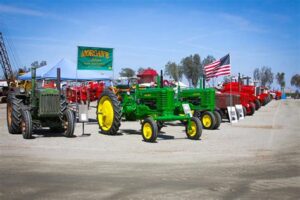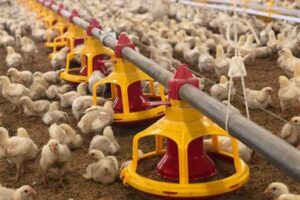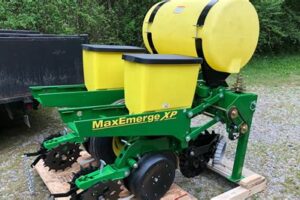Table of Contents
Discover the world of Amish farming equipment, crafted with tradition and precision. Explore a wide range of tools and machinery designed to enhance productivity while adhering to the principles of simplicity and sustainability. From handcrafted plows to innovative horse-drawn implements, experience the rich heritage and efficient practices of Amish farmers. Unveil a harmonious blend of age-old craftsmanship and modern farming techniques, cultivating a deep appreciation for this unique way of life.
The Amish community has long been admired for its commitment to a simple, self-sustaining way of life. Central to this lifestyle is their unique approach to farming, which relies heavily on traditional, hand-powered equipment. In a world dominated by advanced machinery and technology, the Amish’s dedication to their time-honored farming methods is truly captivating. From horse-drawn plows to manual seeders, each piece of Amish farming equipment tells a story of resilience, tradition, and a deep connection to the land. As we delve into the fascinating world of Amish farming, let us explore the ingenuity and efficiency behind their choice of tools, shedding light on a way of life that continues to captivate and inspire.
Introduction
The Amish community is renowned for its commitment to a simple and traditional way of life. This extends to their farming practices, where they rely on horse-drawn equipment and manual tools instead of modern machinery. The Amish farmers’ dedication to sustainable and eco-friendly methods has gained admiration from many around the world.
Horse-Drawn Plows
One of the most iconic and essential pieces of Amish farming equipment is the horse-drawn plow. These sturdy implements are used for tilling the soil and preparing it for planting crops. The Amish have mastered the art of plowing with precision and efficiency, harnessing the power of their trusty workhorses to carry out this crucial task.
Cultivating Tools
Amish farmers employ a variety of cultivating tools to maintain and weed their fields. Handheld hoes, cultivators, and rakes are commonly used for this purpose. By manually removing weeds and aerating the soil, the Amish ensure the health and productivity of their crops without relying on chemical herbicides or pesticides.
Seeders and Planters
When it comes to planting seeds, the Amish have developed ingenious horse-drawn seeders and planters. These carefully crafted machines distribute seeds evenly across the fields, ensuring optimal spacing and reducing waste. By using these traditional tools, the Amish maintain control over their planting process while minimizing their ecological footprint.
Hay Balers
The Amish have also adapted their farming equipment to handle tasks like haymaking. Horse-drawn hay balers compress fresh-cut hay into convenient bales, making it easier to store and transport. With their sturdy construction and dependence on animal power, these hay balers are a testament to the Amish commitment to sustainable practices.
Threshing and Grain Handling
After the harvest, the Amish use horse-powered threshing machines to separate the grain from the straw. These machines are operated by horses walking in circles, driving belts and gears that power the threshing process. This method ensures that the Amish can efficiently process their grains without relying on electricity or fossil fuels.
Wagons and Carts
To transport their crops and equipment, the Amish rely on horse-drawn wagons and carts. These sturdy vehicles are specifically designed to withstand heavy loads and rough terrain. By utilizing wagons and carts instead of trucks or tractors, the Amish reduce their carbon footprint and maintain their commitment to a simpler way of life.
Hand Tools
While horse-drawn equipment plays a significant role in Amish farming, hand tools are also vital to their agricultural practices. Shovels, hoes, rakes, and other manual implements are used for various tasks such as planting, weeding, and harvesting. These tools allow the Amish to work with precision and care, connecting them more intimately with the land they cultivate.
Blacksmithing
The Amish take great pride in their self-sufficiency, including their ability to craft their own farming equipment. Blacksmithing skills have been passed down through generations, ensuring that the community has the necessary tools for their agricultural needs. From plowshares to horseshoes, the Amish blacksmiths produce durable and functional equipment that perfectly aligns with their farming practices.
A Testament to Tradition and Sustainability
The Amish farming equipment is not merely a practical means to an end; it symbolizes the deep-rooted values of tradition and sustainability within the community. By embracing manual labor and horse-drawn machinery, the Amish demonstrate their commitment to stewarding the land responsibly and preserving their cultural heritage for future generations to cherish.
Conclusion
The Amish farming equipment showcases the unique blend of tradition, ingenuity, and sustainability that characterizes the Amish way of life. Through their reliance on horse-drawn tools, manual labor, and blacksmithing skills, the Amish farmers have managed to create a harmonious relationship with the land they cultivate. Their commitment to sustainable practices serves as an inspiration for many seeking a more environmentally conscious approach to farming.
Introduction to Amish Farming Equipment
Amish farming equipment refers to the tools and machinery used by the Amish community for their agricultural practices. In keeping with their traditional and simplistic way of life, the Amish rely on manual and horse-drawn equipment rather than modern machinery.
Traditional Hand Tools
Amish farmers employ a wide range of hand tools, including plows, cultivators, and hoes, to prepare the soil and tend to their crops. These tools are meticulously crafted using time-honored techniques, ensuring their durability and effectiveness. The Amish believe in the value of manual labor and consider these tools an essential part of their farming practices.
Horse-Drawn Implements
Amish farmers commonly use horse-drawn implements, such as plows, planters, and cultivators, to make the most of their agricultural endeavors. Horse-powered equipment allows them to efficiently work on larger fields while minimizing the use of fossil fuels. These well-maintained and sturdy implements are often passed down through generations, embodying the Amish commitment to sustainability.
Amish Buggies and Wagons for Transport
In addition to farming equipment, the Amish utilize their iconic horse-drawn buggies and wagons for transportation purposes. These sturdy vehicles are not only used to move people but also serve as a means to transport harvested crops, livestock, and other agricultural products. The use of buggies and wagons exemplifies the Amish community’s dedication to preserving their cultural heritage and their commitment to a simple and sustainable way of life.
Silage Equipment
Silage, a fermented animal fodder, is a crucial component of Amish livestock farming. To aid in the harvesting and preservation of silage, specialized equipment such as silage choppers, blowers, and storage structures are utilized. Though these mechanized tools are comparatively modern in the realm of Amish farming, they are adapted to work in harmony with the traditional methods practiced by the community.
Sustainable Irrigation Methods
Amish farmers value sustainable and eco-friendly agricultural practices. Rather than relying heavily on energy-intensive irrigation systems, they employ traditional methods such as furrow irrigation and drip irrigation to conserve water and minimize wastage. By using such sustainable techniques, the Amish maintain a harmonious relationship with the natural environment while ensuring the productivity of their farms.
Handmade Farming Equipment Maintenance and Repair
The Amish community prioritizes self-sufficiency and craftsmanship, which extends to the maintenance and repair of their farming equipment. Amish farmers possess the skills to repair and fabricate parts for their machinery, ensuring that their tools remain functional and durable for years to come. This commitment to self-reliance further reinforces their belief in simplicity and sustainability.
Adaptation to Modern Technology
While the Amish generally shun modern technology, they occasionally adapt certain aspects to fit their specific needs. Some innovative Amish farmers have embraced solar-powered equipment, allowing them to reduce reliance on non-renewable energy sources while conforming to their commitment to sustainable agriculture. This selective use of modern technology showcases the Amish community’s ability to balance tradition with practicality in the context of farming practices.
In the world of modern agriculture, where high-tech machinery and advanced equipment have become the norm, the Amish community stands out as a steadfast symbol of tradition and simplicity. Their commitment to living a humble and self-sufficient life is reflected in their approach to farming, which relies heavily on manual labor and traditional farming equipment. While some may view this as outdated or inefficient, there are several reasons why the Amish continue to embrace their traditional farming practices.
- Preservation of Tradition: For the Amish, farming is not just a means of making a living; it is a way of life deeply rooted in their cultural and religious beliefs. By using traditional farming equipment, they honor the traditions passed down through generations and maintain a strong sense of community and identity.
- Simplicity and Sustainability: The Amish prioritize sustainability and self-sufficiency over convenience and technological advancements. They believe that using simple tools and equipment not only reduces their reliance on outside resources but also allows them to live in harmony with the land and nature.
- Low Environmental Impact: Unlike modern farming methods that rely heavily on chemical fertilizers and pesticides, the Amish favor organic farming practices. By using traditional equipment, they minimize their impact on the environment, promoting soil health and biodiversity.
- Fostering a Strong Work Ethic: The physically demanding nature of using traditional farming equipment instills a strong work ethic in the Amish community. The labor-intensive process of tilling, planting, and harvesting crops promotes discipline, perseverance, and a sense of accomplishment.
- Promoting Community Unity: Amish farming practices often require the involvement of the entire community. The use of traditional equipment encourages cooperation and fosters a sense of togetherness, as neighbors come together to help each other with various farming tasks.
- Resisting Materialism: By choosing to rely on traditional farming equipment, the Amish actively resist the temptations of modern consumerism. They prioritize the values of frugality and simplicity, allowing them to focus on what truly matters: faith, family, and community.
While the use of traditional farming equipment by the Amish may seem unconventional in today’s fast-paced world, it is important to recognize and respect their commitment to their beliefs and way of life. Their approach to farming serves as a reminder that there are alternative ways to achieve sustainability, self-sufficiency, and a strong sense of community without relying solely on advanced technology.
Thank you for visiting our blog and taking the time to learn about Amish Farming Equipment. We hope that this article has provided you with valuable insights into the unique and traditional practices followed by the Amish community when it comes to farming. Throughout the article, we have explored the history, benefits, and characteristics of Amish farming equipment, shedding light on how these tools have stood the test of time.
The Amish community takes immense pride in their agricultural practices, which are deeply rooted in their religious beliefs and commitment to a simple way of life. Their farming equipment reflects this dedication, as it is designed to be efficient, durable, and environmentally friendly. By using traditional methods and harnessing the power of horses, the Amish have been able to maintain a sustainable and self-sufficient approach to farming that has been passed down through generations.
One of the remarkable aspects of Amish farming equipment is its longevity. Unlike modern machinery that often requires frequent repairs or replacements, Amish tools are built to last. Crafted with high-quality materials and meticulous attention to detail, these farming implements have proven to withstand the test of time. By investing in Amish equipment, farmers can enjoy the peace of mind that comes with knowing their tools will serve them faithfully year after year.
Beyond their durability, Amish farming tools also offer numerous benefits in terms of efficiency and sustainability. By relying on horse-drawn equipment, the Amish minimize their carbon footprint and reduce their dependency on non-renewable resources. This eco-friendly approach not only helps preserve the environment but also contributes to the development of more sustainable farming practices overall. Furthermore, Amish tools are often designed to perform multiple tasks, maximizing productivity and minimizing labor requirements. This versatility allows farmers to accomplish various tasks efficiently, saving both time and effort.
In conclusion, Amish farming equipment represents a fascinating blend of tradition, craftsmanship, and sustainability. Through their commitment to simplicity and their reliance on horse-drawn machinery, the Amish community has managed to maintain a farming practice that is both efficient and environmentally friendly. By investing in Amish tools, farmers can benefit from their durability, efficiency, and versatility, ensuring a sustainable future for their agricultural endeavors. We hope that you have found this article insightful and informative, and we encourage you to explore further into the fascinating world of Amish farming equipment. Thank you once again for visiting our blog!
Video Amish Farming Equipment
People Also Ask About Amish Farming Equipment:
- What type of farming equipment do the Amish use?
- Why do the Amish prefer manual farming equipment?
- Are there any exceptions to the use of modern farming equipment among the Amish?
- Where do the Amish acquire their farming equipment?
- How do Amish farmers maintain their farming equipment without electricity?
The Amish primarily rely on traditional manual farming methods and tools. These may include horse-drawn plows, cultivators, harrows, and hay rakes. They avoid using modern machinery such as tractors or combine harvesters.
The Amish value simplicity, self-sufficiency, and a close connection with nature. Manual farming equipment allows them to maintain their traditional way of life while minimizing dependence on technology and external resources. It also aligns with their belief in the importance of physical labor and community cooperation.
While the majority of Amish communities adhere strictly to traditional farming methods, some communities have made limited exceptions. In certain cases, they may use modern technology such as diesel-powered engines to operate various farming tools. These exceptions are typically carefully considered and decided upon collectively by the community.
The Amish often create their own farming equipment or rely on skilled local craftsmen within their community to build or repair tools. They may also acquire equipment from other Amish farmers or second-hand sources. The Amish prioritize sustainability and durability, ensuring that their farming equipment is built to last.
Amish farmers employ various alternative methods to maintain their farming equipment without electricity. These may include utilizing non-electrical tools like hand drills, hand saws, and hand crank mechanisms. Additionally, they often rely on manual labor and the expertise of skilled craftsmen within their community to repair or replace any worn-out parts.






